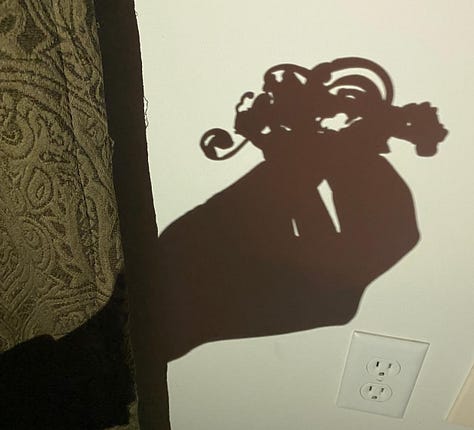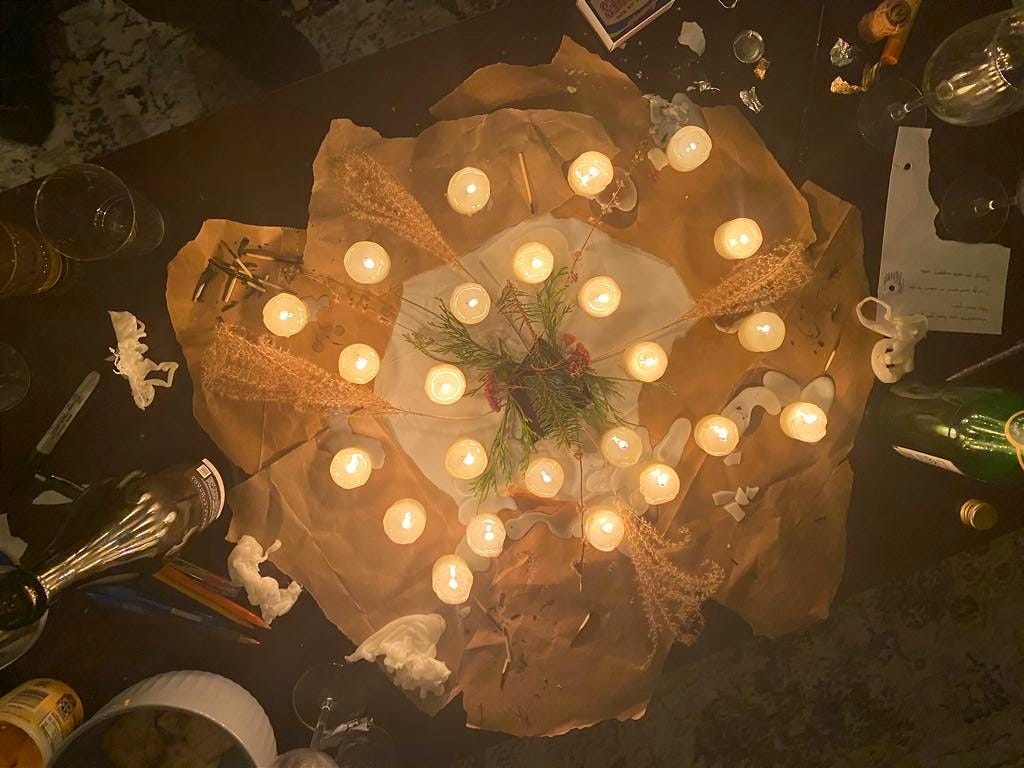On Accumulation
This new year’s eve marks ten years that my best friends and I, along with our combined constellation partners and children, have gotten together for the new year’s holiday.
This tradition began on the cusp of our 30s, with a desire to legitimize our growing commitment to our friend trio as chosen family by assigning it a family holiday. Thanksgiving and Christmas were ultimately deemed unworkable, and I have always loudly claimed new year’s as my favorite holiday (I love both champagne and self-reflection), so that’s the one we agreed on. Since we’ve mostly not lived near each other, this has meant an expectation of travel — we rent a cabin for three or four nights wherever we can all get to; we cook, eat, hopefully sit in a hot tub, and perform some homemade rituals.
The process has not been without friction. Every time a curveball has forced us to adjust our plans, (and by curveball I mean anything from the flu to a new partner, a new baby, a divorce), I have watched the delicate balance of our commitments wobble and half expected the whole thing to come apart. There have also been several years when I, resentful about carrying a disproportionate load of the planning or execution, have initiated tense conversations beginning with “do you guys actually want to do this?” I’ve worried about a slow slide from fun into obligation, and wondered over the necessary ratio of desire to obligation to keep a thing going.
Despite all this, it has kept going. The kids ask which rituals we’re doing this year, and have opinions about which ones they prefer. I am digging through my stock of candles. There is a hot tub, and the lady has assured me it works. Mo will make hoppin’ john for dinner on the 1st. We might decide to let it all go at some point, but that would have to be a conversation — the thing we would have to talk about is *not* doing it, because doing it has become the default. It began as something we made up, and through repetition it has taken shape. We made it real.
*
I’ve been writing this Substack for a year now, which is a milestone that doesn’t have to matter to you but matters to me. I feel pride in the accumulation. The pride is a little bit about the writing itself, but it’s perhaps more about just having done the thing. A year ago it didn’t exist, and now it does.
I recently mentioned to a new acquaintance that I have a Substack, and she asked what it’s about. I hesitated. Uhhhh, writing? (Too vague.) Theater. (Oh god, nobody wants to read about theater.) Wait, why don’t I have this answer ready? What is it actually about?
Naming this Substack was like naming a play before writing it: a shot in the dark, somewhere between a guess at a theme and a prompt to myself. But actually, I think it has held true. Almost all of being an artist feels like new year’s: you start with something that’s obviously made up, and you make it real by doing it, over and over and over.
*
I am big on resolutions, which is maybe a bit strange since I am not big on succeeding at resolutions. I find that, by my age, most people have either dismissed new year’s resolutions as bourgeois or have become those annoying people who are constantly setting goals and achieving them ahead of schedule. I guess, despite not being all that good at it, I am interested in change. How does a person change? How does a situation change? This year I have been noticing how much change happens through quiet accumulation. Far more, in my life at least, than happens through big moments of decision, or leaps. And yes, my career is almost all accumulation: little tasks that are largely invisible to others, piling up in such a way that sometimes a shiny bauble on top of the pile — an award or residency or reading — catches the eye of those around me, causing them to exclaim, “Oh, cool!” in a way that means, “I guess that thing you’re doing is real. Huh.”
*
It takes bravery to do something made up. But I think the path from imagined to real is perhaps more simple than we assume: it’s just continuing to do the thing, not exactly as you planned to do it, but in whatever way it turns out to be possible. It’s continuing through the wobbles: past the easy enthusiasm of beginning, past your illusions that it’s going to be perfect, or even go well, on through the days when it feels like an obligation, and a silly one at that.
The energy of making something real is not the same energy you employ to assess a thing’s worth. I have so much appreciation for the matriarchs in my life who have built and reinforced the sturdy, imperfect structures of holidays: the foods we eat, the gifts, the decorations. They didn’t invent Christmas, of course — they had a blueprint to work from — but it’s only because of their diligence that I am free to feel by turns indifferent or enthusiastic about it. What a gift it is, the work of making a tradition real, so that we can inherit or reject it.
When we make something up, we have to be our own matriarchs. We have to say yes, of course, I will write this as though there are people wanting to read it. Yes of course, I will carefully construct the new year’s table as though my friends are eager to gather, and light candles, and dip wax, and tell stories, and swallow ashes at midnight. We have to give ourselves that gift with the same determination that our mothers and grandmothers heave those bins of Christmas ornaments out of the attic every December. So that there is something here, on the calendar, on the page. Something to improve upon, complain about. Something to work with.
*
I’m going to close this out with an offering and a request. The offering is four of our favorite new year’s rituals, which I am gifting to you in case you would like an activity to carry you across the border from one year to the next. Two were originally borrowed from other parts of the world; the other two are entirely made up. All four are real to us now, and can be to you as well, if you would like.
The request is, if you have been a reader for a while here, that you press “reply” on this email and tell me whether there is something you would like to hear more about in the coming year. I’m curious why you’re still here, reading my emails. Tell me what themes or preoccupations have resonated with you, that I might continue shaping this accumulation into what it wants to be.
*
Ok, so. The rituals. (We don’t generally do all of these in one year, by the way; we mix and match, depending on our mood.)
Gremlins. This one is best if you’re near a body of water.
Make salt dough. Use it to sculpt little creatures or talismans of things that have haunted and hounded you in the past year. Bake them til they’re hard; paint and decorate them lovingly. Leave them around on new year’s eve. On new year’s day, go hurl them into the lake/river/ocean.
Wax fortunes.
Individually, each person melts a small chunk of wax. (I use an old tin can to make a double boiler in a saucepan.) When the wax is liquid, the person pours it into a bowl of ice water. The wax will harden into a shape. Once everybody has made one, use a flashlight to cast the shadow of your wax lump onto the wall. Tell each other’s fortunes for the coming year based on the shadows. (You can also just tell fortunes based on the shapes of the wax themselves, sans shadow, but we’ve found that the shadows often make more distinctive and legible images.)
Telling stories in the dark.
This one started as a winter solstice activity, but given the crunch of other December holidays and obligations, I rarely have a solstice party. So we’ve ended up using it at new year’s, which I sometimes think of as solstice ten days late.
You’ll want to decide on some prompts ahead of time. The prompts are for sharing things about the past year. They should be open-ended and invite the sharing of things you might not have told each other. (Examples: something new that entered your life this year. something you thought about a lot this year. proudest/happiest moment of the year. shittiest/hardest moment of the year. weirdest/most surprising moment of the year. something you no longer care about that you cared about this time last year. )
Light a table full of candles. At least 3 for every person present, more if possible. Turn off every other light, close curtains, make your space dark. Settle in.
Once you’re ready, and there has been some silence, you can start sharing. Every time someone shares, they blow out a candle.
Go slow.
Go until every candle is out, and you’re sitting in the dark.
Sit in the dark together.
(We don’t have one consistent way of ending this ritual, but it’s good to make a plan in advance. If you have a good singer in the group, elect them to eventually start a song. Sing in the dark and then turn the lights back on. Alternately, you can have some pots and pans on the ready, and when you decide it’s time to break out of the dark cocoon, somebody can start banging and everyone can join in and run outside making a great ruckus.)
Ashes in champagne.
(This is also a good way to transition out of the previous activity — we often link them by relighting a single candle just before midnight.)
Write your intention for the coming year down on a small strip of paper. At midnight, light the paper on fire and burn it over your glass of champagne. Drop it in, drink the ashes.
*
xo, Addie




